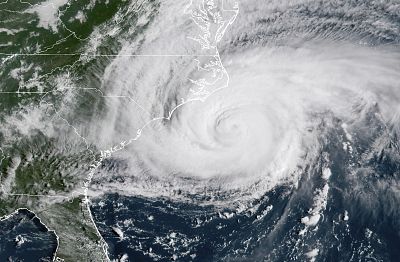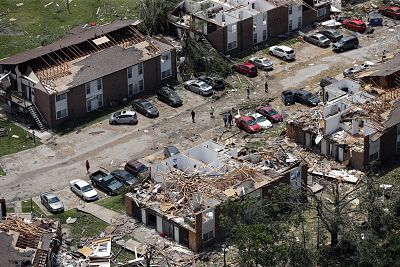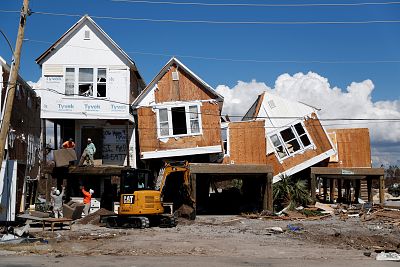Hurricanes and tornadoes produce strong, swirling winds, but they differ in size and duration as well as in how, when and where they form.
Hurricanes and tornadoes are alike in basic ways. Both produce powerful, swirling winds — and both can leave a path of death and destruction. But hurricanes and tornadoes also differ in crucial ways, including their size and duration as well as how, when and where they form.
The biggest differences between hurricanes and tornadoes are how big they are and how long they last. Hurricanes are typically hundreds of miles in diameter, with high winds and heavy rains over the entire region. The largest hurricane ever to hit the United States was Sandy in 2012, which was 1,000 miles wide when it slammed into New York and New Jersey, causing more than $70 billion worth of damage and more than 175 deaths.
Tornadoes are typically no more than a few hundred feet wide — although one twister that touched down in central Oklahoma in 2013 was more than two miles wide.
Hurricanes can last for days or even weeks. Tornadoes usually last no more than a few minutes.
How and when do hurricanes form?
Hurricanes form over the Atlantic and Pacific oceans, near the equator and far from land. "Their energy source is the warm ocean waters," says Richard Pasch, a senior hurricane specialist at the National Hurricane Center in Miami.
A hurricane typically starts as a wave of low-pressure air in the warm, moisture-rich atmosphere over the tropical ocean. The gathering storm draws in warm air and water vapor as it rises and grows, forming thunderclouds and starting to rotate in response to Earth's rotation.
In the Northern Hemisphere, hurricanes spin counterclockwise and are typically driven roughly northwest by the trade winds. In the Southern Hemisphere, these storms rotate clockwise.
Hurricanes are called typhoons in Asia and the western Pacific, and cyclones in Australia and the Indian Ocean.
Most hurricanes hit the U.S. in summer and early fall, when the Northern Hemisphere's oceans are warmest. During a typical Atlantic hurricane season, which runs from June 1 to Nov. 30, an average of 12 hurricanes hit the United States along the coast of the Gulf of Mexico or the Atlantic coast.
How and when do tornadoes form?
Tornadoes, or twisters, form over land during so-called supercell thunderstorms, which produce powerful updrafts of wind that twist as they rise, says Bill Bunting, the chief of forecast operations at the National Weather Service's Storm Prediction Center in Norman, Oklahoma.
Under certain conditions, the updrafts of a supercell storm narrow to form a rapidly swirling funnel cloud — and then a tornado.
Bunting says the conditions that encourage the formation of tornadoes — including the collision of warm, humid air and cold, dry air — prevail between March and early June across what's commonly referred to as Tornado Alley, an area that spans parts of Texas, Oklahoma, Kansas, Nebraska and South Dakota. But tornadoes can form at any time of year and in any area.
Occasionally, tornadoes form over water to form twisters known as waterspouts.
How fast are a hurricane's winds?
Hurricanes are rated on a five-point scale known as the Saffir-Simpson Hurricane Wind Scale.
Category 1 hurricanes produce sustained winds of 74 to 95 miles per hour — enough to break tree branches and cause minor damage to buildings and other structures. Category 2 hurricanes (with sustained winds of 96 to 110 mph) can cause heavy damage to houses. Category 3 hurricanes (with sustained winds of 111 to 129 mph) can uproot trees and down power lines and damage buildings. Category 4 hurricanes (130 to 156 mph winds) can tear the roofs off houses.
Science
The most severe hurricanes, rated Category 5, produce sustained winds of 157 mph or more. These storms can destroy houses and make entire areas uninhabitable for weeks or months.
How fast are a tornado's winds?
Tornadoes are rated according to a six-point scale known as the Enhanced Fujita Scale.
EF-0 tornadoes produce wind gusts of 65 mph to 85 mph — enough to break tree branches. EF-1 tornadoes produce gusts of 86 mph to 110 mph — enough to damage buildings. EF-2 tornadoes produce gusts of 111 to 135 mph — enough to tear off roofs. EF-3 tornadoes produce gusts of 136 to 165 mph — enough to lift cars and trucks off the ground. EF-4 tornadoes produce gusts of 166 to 200 mph — enough to destroy houses.
The most powerful tornadoes, rated EF-5, produce gusts in excess of 200 miles per hour. They can sweep away bridges and topple tall buildings.
Can hurricanes and tornadoes happen together?
Hurricanes often spawn tornadoes as they make landfall. That was the case in 2017, when the Category 5 Hurricane Irma slammed into the Florida Keys.
How does climate change affect hurricanes and tornadoes?
Studies suggest that powerful hurricanes will become more common as the climate warms, though Pasch says meteorologists haven't yet detected any uptick. Hurricanes could also dump more rain, raising the risk of severe flooding, in a warmer climate.
Bunting says it's too early to tell if climate change is making a difference in the frequency and severity of tornadoes. He says U.S. records of tornadoes go back only to 1950, with detailed records made only in recent years. "There are limitations of the tornado database that make it hard to really answer that question," he says.
Want more stories about the environment?
- 1 million species under threat of extinction because of humans, new report finds
- Your clothes are secretly polluting the environment. Here's why you should be concerned.
- This floating city concept is one way to cope with climate change
SIGN UP FOR THE MACH NEWSLETTER AND FOLLOW NBC NEWS MACH ON TWITTER, FACEBOOK, AND INSTAGRAM.














